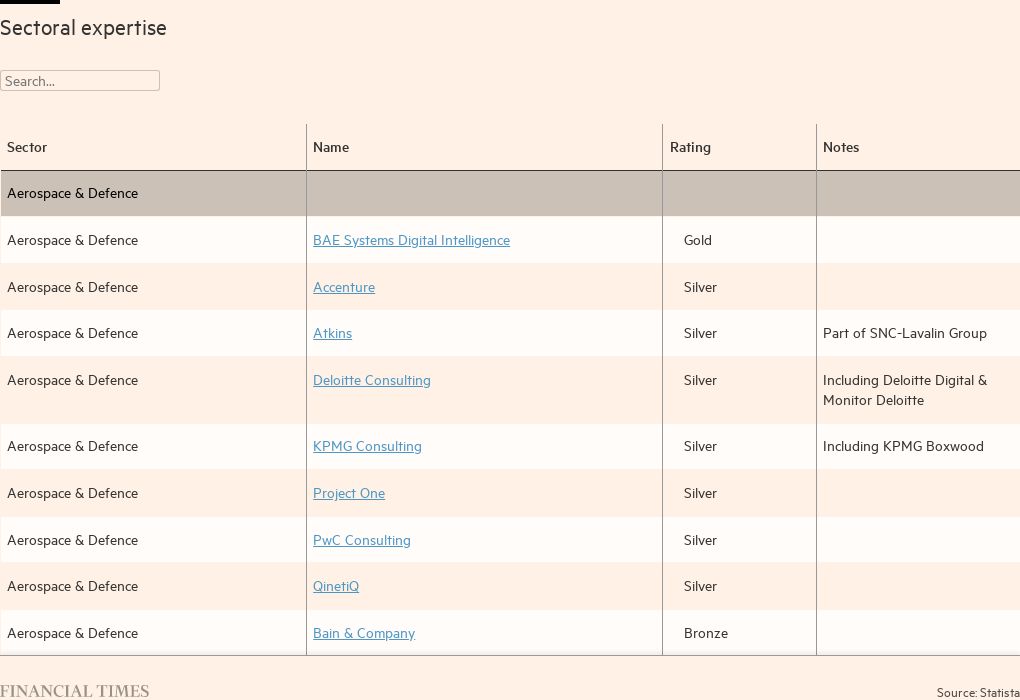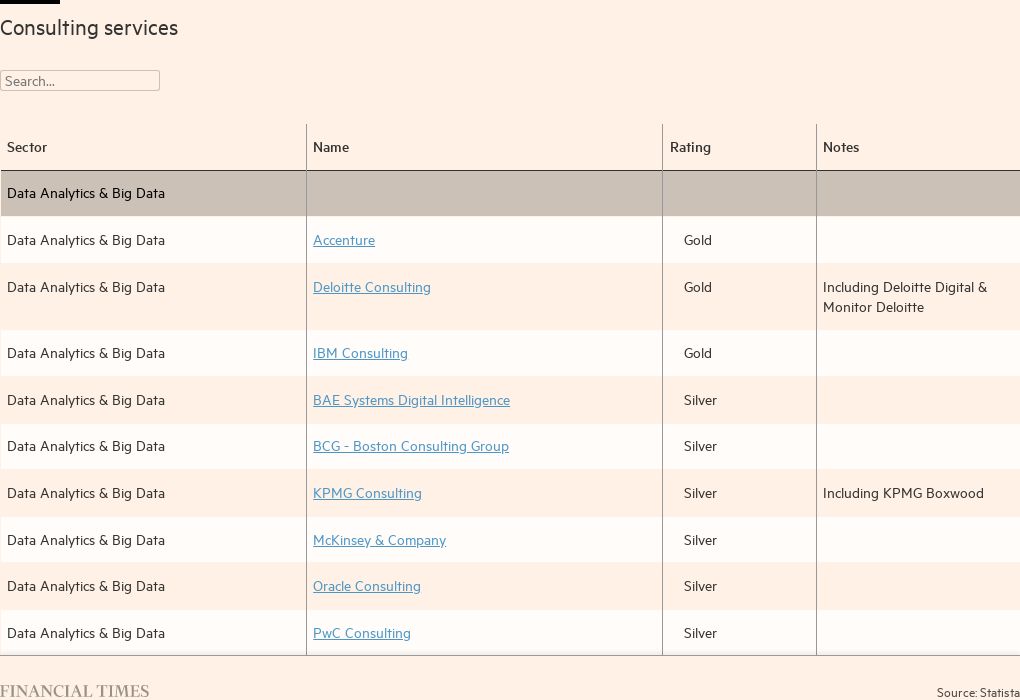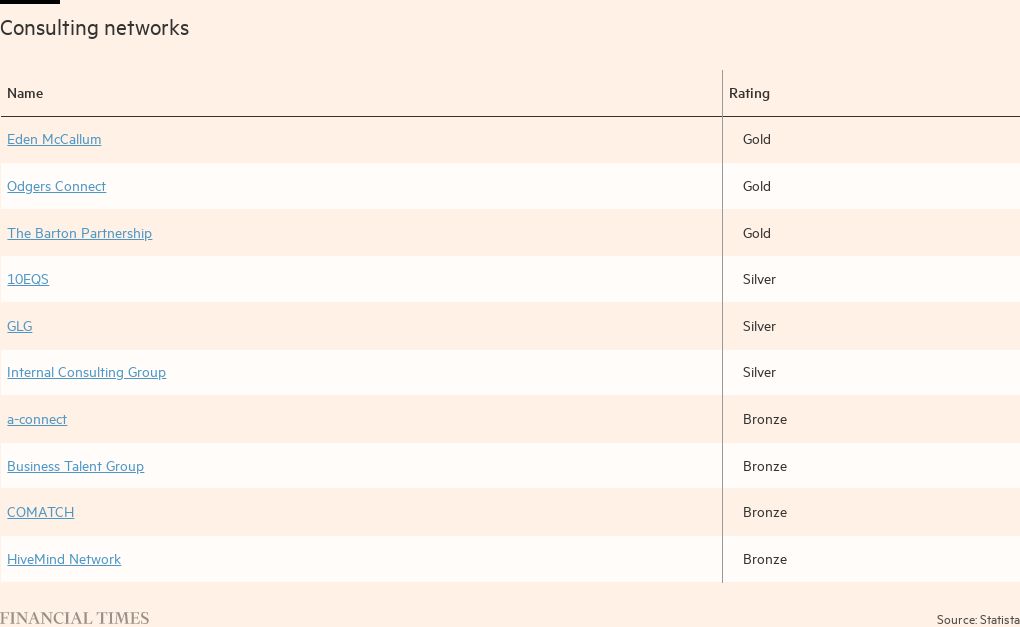UK’s Leading Management Consultants 2023: the ratings

Simply sign up to the Management consulting myFT Digest -- delivered directly to your inbox.
This is the sixth annual listing of the UK management consulting firms most recommended by their clients and peers. Compiled by the Financial Times and Statista, the data company, it rates consultants in 15 sectors and for 14 types of specialist work. Consulting networks were rated as well, for the second year.
The results are based on three surveys of consultants’ clients and peers, carried out by Statista, with gold, silver or bronze ratings awarded to firms and networks in different categories according to how often they are recommended.
This year, 185 consultancies are included, receiving a total of 745 ratings across 29 different industries and consulting services.

The methodology (after the tables) explains how the ratings are worked out.
Sector expertise
Sectors listed: aerospace & defence; automotive; chemicals & pharmaceuticals; construction & infrastructure; consumer goods & retail; energy, utilities & environment; financial institutions & services; healthcare & life sciences; insurance; internet, media & entertainment; IT, technology & communications; oil & gas; other industries & metals; public & social sector; travel, transportation & logistics
Consulting services
Categories listed: data analytics & big data; digital transformation; finance, risk & compliance; innovation, growth & new business models; IT - implementation; IT - strategy; marketing, brand & pricing; mergers & acquisitions; operations & supply chain; organisation & change; people & performance; sales & CRM; strategy; sustainability
Consulting networks
Methodology and notes
Market definition
Mainstream management consulting firms, IT consultancies, advisory branches of auditing firms, the consultancy branches of technology companies, and consulting networks were eligible.
Methodology
The list is based on three surveys; one among peers (partners and executives from consultancies evaluated other consultancies) and two among clients (on consultancies they have worked with). Both surveys were conducted online by Statista.
Peer survey
Building on last year’s methodology, a longlist of more than 1,700 firms was used as a basis for the latest survey among peers. To update the longlist, Statista used recommendations from previous years and these sources: lists from associations (eg Management Consultancies Association); consulting directories (eg Consultingcase101); and company databases. The list of consulting partners and executives was compiled using research conducted mainly on firms’ websites. It was also possible to register for the survey on ft.com. The sample included more than 4,000 partners and executives of UK firms.
More stories from this report
Invitations to the survey were sent via an email containing a personalised link. The field research period ran from June 20 to August 16 2022. Partners and executives could make recommendations in 15 sectors and for 14 consulting services, and could recommend consulting networks. Respondents were also able to name consultancies or networks they would refrain from recommending.
An autocomplete function was available to assist in selecting a consultancy or network and respondents could recommend any consultancy that did not appear in the autocomplete list, or add a negative evaluation. A score was given to each firm based on the number of positive and negative recommendations they received. Self-recommendations were excluded.
Client surveys
Two online surveys were then conducted among about 1,500 senior executives who have used management consultancies in the past four years. They either registered themselves for the surveys on ft.com between June 20 and August 16 2022, or were recruited through an online access panel from September 6-25 2022.
Respondents were asked to indicate the sectors or consulting services in which they had collaborated with a management consultancy in the past four years. They were asked to recommend firms by using autofill or adding names. For each sector or consulting service they specified, the respondents were given a list of recommended consultancies for evaluation. The quality of the firms and networks was scored using a five-point scale (very good to very poor). The evaluations “very good”, “good” and “acceptable” counted as recommendations (“very good” counted as one recommendation, “good” and “acceptable” carried a lower weight). The evaluations “poor” and “very poor” counted against consultancies and networks. Reputation is typically built over several years and this list aims to reflect that longevity. Therefore, last year’s results were taken into account, attributed a low weighting.
Recommendations
In each sector and consulting service, firms were sorted according to the number of recommendations (taking into account a reduction for negative evaluations).
The groups were placed in the classes below, based on the average number of recommendations in that sector or service:
• Consultancies and networks that received well above the average number of recommendations were sorted into the gold class, “very frequently recommended”. The number of recommendations was at least two times larger than the average for each sector or consulting service.
• Consultancies and networks that received fewer recommendations, but were still above average, were sorted into the silver class, “frequently recommended”. The number of recommendations was less than double, but more than the average for each sector or consulting service.
• Consultancies and networks that still received a significant number of recommendations from peers and clients were sorted into the bronze class, “recommended”, within their industry or sector.
• Consultancies and networks with insufficient recommendations were excluded. Consultancies are sorted alphabetically in each class.
Disclaimer
The ranking comprises firms with a sufficient number of recommendations; a mention is positive and is a vote of confidence from the market. The ranking was created through a complex process. The quality of consultancies not included is not disputed.



Comments